

The bilingualism challenge - learning world. Jim Cummins - Bilingualism & Language Acquisition - InfoGuides at George Mason University. Articles Stille, S.
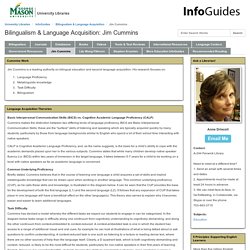
& Cummins, J. (2013). Foundation for learning: Engaging plurilingual students' linguistic repertoires in the elementary classroom. TESOL Quarterly, 47, 630–638 doi: 10.1002/tesq.116 Cummins, J. (2012). The intersection of cognitive and sociocultural factors in the development of reading comprehension among immigrant students. Reading & Writing, 25, 1973 – 1990 doi: 10.1007/s11145-010-9290-7 Cummins, J. (2011). Cummins, J. (2009). Bernhard, J.K., Cummins, J., Campoy F.I. Cummins, J. (2005). Bilingual Education.
Issues in U.S.
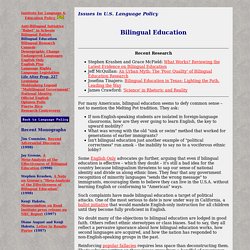
Language Policy Recent Research For many Americans, bilingual education seems to defy common sense – not to mention the Melting Pot tradition. Bilingualism and Bilingual Education. Seen simply, bilingualism is the ability to perform in two languages.

As seen in the Introduction to MBE the issue is more complex than it appears. Cummins: Immersion Education for the Millennium. Immersion Education for the Millennium: What We Have Learned from 30 Years of Research on Second Language Immersion Jim Cummins Ontario Institute for Studies in Education of the University of Toronto The term "immersion education" came to prominence in Canada during the 1960s to describe innovative programs in which the French language was used as a medium of instruction for elementary school students whose home language was English.
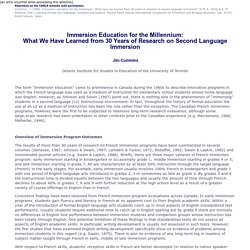
However, as Johnson and Swain (1997) point out, there is nothing new in the phenomenon of "immersing" students in a second language (L2) instructional environment. In fact, throughout the history of formal education the use of an L2 as a medium of instruction has been the rule rather than the exception. Overview of Immersion Program Outcomes Consistent findings have been obtained from French immersion program evaluations across Canada.
Core Features of Immersion Programs. LearnZillion. DCExp_Inicial_Primaria_EIB_2012_ Educacion Bilingüe. Revista e-CO. Hoy, 23 de abril, Día Internacional del Libro, fiel a su cita anual, la revista e-CO del Centro del Profesorado de Córdoba presenta un nuevo número, el duodécimo, haciendo así nuestro pequeño homenaje y contribución a esta efeméride que tanta repercusión y protagonismo tiene en los centros educativos.
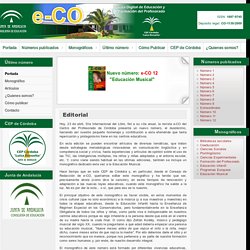
En esta edición se pueden encontrar artículos de diversas temáticas, que tratan desde estrategias metodológicas innovadoras en comunicación lingüística y en competencia social y cívica, hasta experiencias y artículos de opinión sobre el uso de las TIC, las inteligencias múltiples, los niños y niñas adoptados y el entorno escolar, etc. Y, como viene siendo habitual en las últimas ediciones, también se incluye un monográfico dedicado esta vez a la Educación Musical. CLIL - Content and Language Integrated Learning- What is CLIL? The Handbook of Bilingual and Multilingual Education - Wayne E. Wright, Sovicheth Boun, Ofelia GarcÃa. NABE - Bilingual Education. Why Bilingual Education?

ERIC Digest by Stephen Krashen Bilingual education continues to receive criticism in the national media. This Digest examines some of the criticism, and its effect on public opinion, which often is based on misconceptions about bilingual education's goals and practice. The Digest explains the rationale underlying good bilingual education programs and summarizes research findings about their effectiveness. Articles-353338_archivo_pdf. Formación Docente para la Calidad Educativa. Formación Docente para la Calidad Educativa. Formación Docente para la Calidad Educativa. Amazing Classrooms: Spanish Immersion. Aguirre habla en inglés sobre la enseñanza bilingüe.
Centros Bilingües.Presentación y preparación de una sesión CLIL. Educación bilingüe en la infancia. Noticias en infantil. Info AW Nº27. ABC de la Internacionalización by Gina Ortiz on Prezi. Linguistics for Language Learners: What is the IPA? In Part 1 of our Linguistics series, we introduced the International Phonetic Alphabet (IPA) and talked about why it’s a great tool for language learners.

Today we’re going to go a little deeper into what the IPA really is. I’m going to focus on what I found most useful as I was studying Arabic, and as I dabbled in learning German and Dutch. This is just an intro to understand the “bones” of the IPA so you can navigate it like a boss. Head’s up, anytime I use an IPA symbol, it will be in brackets like this: [θ] or [œ]. If I tell you to say [d], I don’t mean the name of the letter in the English alphabet, which would sound like dee. Vowels in the IPA Here’s the IPA vowel chart.
Vowels are organized by the tongue’s position in the mouth: it can be front (up close to the teeth), central, or back (pulled back toward the throat), as well as high, mid, or low. Let’s play a pronunciation game. Proyecto_pedagogico_unadista.pdf. La_Sabana_2014_general_presentation. Pensar_para_aprender_Sabana_14. Test de nivel de Inglés. The Key to Boosting English Learners’ Language Skills? Challenging Content. The English language learner population in the United States is growing quickly, posing a challenge for cash-strapped schools struggling to balance the diverse needs of learners.
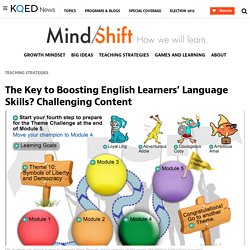
And while technology is becoming a more ubiquitous part of the school experience, it hasn’t always been used effectively to improve the language skills of English learners. A new curriculum using both online modules and teacher-led instruction developed by Middlebury Interactive Languages in partnership with Hartford Public Schools is showing promise as an engaging way for students working on their English skills to also access challenging content. Middlebury Interactive Languages is known for its online world languages program, but the partnership with Hartford marks the company’s entry into developing a blended-learning program meant for students learning English.
In comparison, the Middlebury blended curriculum is grouped by overarching themes and subthemes.